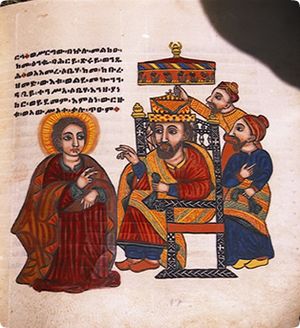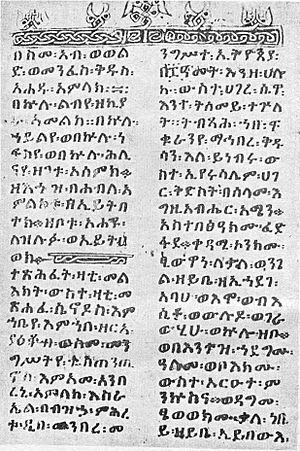Zara Yaqob facts for kids
Quick facts for kids Zara Yaqobዘርዐ ያዕቆብ |
|||||
|---|---|---|---|---|---|
| Negusa Nagast | |||||

Contemporary Ethiopian portrait of Zara Yacob's coronation
|
|||||
| Emperor of Ethiopia | |||||
| Reign | 1434–1468 | ||||
| Coronation | 1436 | ||||
| Predecessor | Amda Iyasus | ||||
| Successor | Baeda Maryam I | ||||
| Born | 1399 Telq, Fatagar, Ethiopian Empire |
||||
| Died | 26 August 1468 (aged 68–69) | ||||
| Spouse | Eleni Seyon Morgasa Gera Ba'altihat |
||||
| Issue | Baeda Maryam I Galawdewos Amda Maryam Zar'a Abraham Batra Seyon Del Samera Rom Ganayala Adal Mangesha Berhan Zamada Madhen Zamada Sabala Maryam Del Debaba |
||||
|
|||||
| Dynasty | House of Solomon | ||||
| Father | Dawit I | ||||
| Mother | 'Egzi'e Kebra | ||||
| Religion | Ethiopian Orthodox Tewahedo | ||||
Zara Yaqob (Ge'ez: ዘርዐ ያዕቆብ; 1399 – 26 August 1468) was an important Emperor of Ethiopia. He was part of the Solomonic dynasty and ruled under the name Kwestantinos I (Ge'ez: ቈስታንቲኖስ, "Constantine"). He is remembered for a time when Ge'ez literature, a type of writing, became very popular. He also managed important Christian matters and fought wars against Muslim groups. Zara Yaqob founded Debre Birhan, which became his capital city. He ruled for 34 years and 2 months.
A British historian named Edward Ullendorff said that Zara Yaqob was the greatest ruler Ethiopia had seen in a very long time. Only Emperors Menelik II and Haile Selassie could be compared to him later on.
Contents
Becoming Emperor
Some stories say that Zara Yaqob's older brother, Emperor Tewodros I, was jealous of him. Because of this, Zara Yaqob was secretly raised in Tigray. He studied in Axum and at the Debre Abbay monastery. However, other historians believe this story is unlikely.
Zara Yaqob himself wrote that he was kept in a royal prison on Mount Gishan. He was only brought out just before he became emperor. After his father, Emperor Dawit, died, his brother Tewodros ordered Zara Yaqob to be confined around 1414.
Even while he was confined, Zara Yaqob's supporters wanted him to be emperor. Many of his older brothers ruled for short periods over the next 20 years. This meant Zara Yaqob became the oldest qualified person to take the throne.
Being kept away from ordinary life for so long affected Zara Yaqob. When he became leader, he had no experience with how the government worked. His kingdom was full of plots and rebellions. The Church was divided by different beliefs, and enemies often threatened to invade.
Because of these difficult situations, Zara Yaqob became very determined and strict. He was not very flexible or diplomatic. Towards the end of his life, he became lonely and suspicious, even of his own family. But despite these challenges, he is still remembered as a great defender of the faith in Ethiopian history.
Zara Yaqob became Emperor in 1434. However, he was not crowned until 1436 in Axum. He lived there for three years. It was common for Ethiopian rulers to wait to have their coronation later in their reign.
Dealing with Challenges
After Zara Yaqob became emperor, a ruler named Garad Mahiko from the Hadiya Sultanate refused to accept his rule. With help from one of Mahiko's followers, Mahiko was removed from power. His uncle Bamo took his place. Garad Mahiko then went to the court of the Adal Sultanate for safety. However, soldiers from Ethiopia found and killed him. They sent his head and body parts to Zara Yaqob as proof.
Zara Yaqob invaded Hadiya because they did not pay their yearly tribute to the Ethiopian Empire. He married Princess Eleni from Hadiya. She was baptized before their marriage. Eleni was the daughter of the former king of Hadiya, Garad Mehamed. Even though she did not have children with Zara Yaqob, Eleni became a very powerful political figure.
When Zara Yaqob discovered a plot against him involving some of his officials, he reacted strongly. He appointed his two daughters, Medhan Zamada and Berhan Zamada, to important government positions. His chronicles also say he made his daughters and nieces governors of eight provinces. However, these appointments were not very successful.
In 1445, Zara Yaqob defeated Badlay ad-Din, the Sultan of Adal, at the Battle of Gomit. This victory helped him control the kingdoms in the south. He also gained more power over the weaker Muslim kingdoms beyond the Awash River. He also led campaigns in the north against the Agaw and the Falasha, but these were not as successful. The title of the ruler of the coastal regions, Bahr Negash, first appeared during Zara Yaqob's reign. He might have even created this position.
In 1456, Zara Yaqob saw a bright light in the sky. Most historians believe this was Halley's Comet. After seeing this, he founded Debre Berhan and made it his capital city for the rest of his rule.
In his later years, Zara Yaqob became very strict. When an abbot (a leader of a monastery) named Takla Hawariat criticized him, Zara Yaqob had the abbot beaten and imprisoned. The abbot died a few months later. In 1453, Zara Yaqob became convinced there was a plot against him. This led to more harsh actions. He increasingly believed his wife and children were plotting against him and had some of them beaten. Seyon Morgasa, the mother of the future emperor Baeda Maryam I, died from this treatment in 1462. This caused a complete break between Zara Yaqob and his son. Eventually, they made up, and Zara Yaqob publicly named Baeda Maryam as his successor.
Near the end of his reign, around 1464 or 1465, Zara Yaqob's forces attacked Massawa and the Dahlak archipelago. The Sultanate of Dahlak was then forced to pay tribute to the Ethiopian Empire.
A manuscript from 1784 says that Zara Yaqob punished many people who worshipped pagan gods. These people were publicly executed. Spies also said that some of his sons and daughters were idolaters, and they were also executed.
Later, in the 1500s, an Adal leader named Ahmed ibn Ibrahim al-Ghazi ordered the destruction of Zara Yaqob's old palace in Debre Birhan.
Changes to the Church
When Zara Yaqob became emperor, the Ethiopian Church had been divided for about 100 years. The disagreement was about when to observe the Biblical Sabbath (day of rest). One group, loyal to the Coptic Orthodox Church of Alexandria, believed the day of rest should only be Sunday. Another group, followers of Ewostatewos, believed both Saturday (the original Sabbath) and Sunday should be observed.
Zara Yaqob successfully convinced two Egyptian church leaders, Mikael and Gabriel, to agree to a compromise. This was meant to bring peace with the followers of Ewostatewos. The Ewostathians agreed to the compromise by 1442. The two Egyptian leaders agreed at a meeting in Tegulet in 1450.
Zara Yaqob also continued to defend the leader of the Patriarch of Alexandria. In 1441, he heard that an Egyptian monastery was destroyed by the Mamluk sultan of Egypt. Zara Yaqob declared a time of mourning. He then sent a strong letter of protest to the Sultan. He reminded the Sultan that he treated his Muslim subjects fairly. He also warned that he had the power to change the course of the Nile River, but he chose not to because of the human suffering it would cause. The Sultan responded with gifts to calm Zara Yaqob's anger. However, he refused to rebuild the churches he had destroyed.
According to Richard Pankhurst, Zara Yaqob was also a famous writer. He wrote at least three important religious books. One was Mahsafa Berha, meaning "The Book of Light." This book explained his church reforms and defended his religious beliefs. The others were Mahsafa Milad ("The Book of Nativity") and Mahsafa Selassie ("The Book of the Trinity").
Connecting with Other Countries

Zara Yaqob sent people to the Council of Florence in 1441. This helped him create connections with the Holy See and Western Christianity. His delegates were confused when people at the council kept calling their emperor "Prester John." They tried to explain that this title was not on Zara Yaqob's list of names. However, their explanations did not stop Europeans from calling the Ethiopian emperor by this mythical Christian king's name.
He also sent a group of diplomats to Europe in 1450. They were looking for skilled workers. The mission was led by Pietro Rombulo, who was from Sicily. Rombulo first visited Pope Nicholas V. His main goal was to reach the court of Alfonso V of Aragon, who responded positively to the request. Two letters from Ethiopians in the holy land (from Amda Seyon and Zara Yaqob) are still in the Vatican library. They refer to "the kings Ethiopia."
See also
 In Spanish: Zara Yaqob para niños
In Spanish: Zara Yaqob para niños

